Impact of Voice Recognition Technology on Peppers Broadbeach Tourism
VerifiedAdded on 2023/06/08
|9
|2588
|129
Report
AI Summary
This report provides a comprehensive analysis of the impact of voice recognition technology in the tourism industry, with a specific focus on Peppers Broadbeach. It begins with an introduction to the role of technology in enhancing customer experience and streamlining operations within the tourism sector, highlighting the increasing importance of voice recognition powered by artificial intelligence. The report then offers an overview of Peppers Broadbeach, discussing its services and existing technological infrastructure. It delves into the current technology trends, especially voice recognition, and their implications for the company, including the benefits of improved customer interaction and accessibility. The report also identifies challenges associated with voice recognition, such as limitations in understanding speech variations and the impact of noise. A business model canvas is used to analyze customer segments, value propositions, and key activities. Finally, the report concludes with recommendations for further technological adoption, including smart room keys and infrared scanners, to enhance guest experience and operational efficiency.
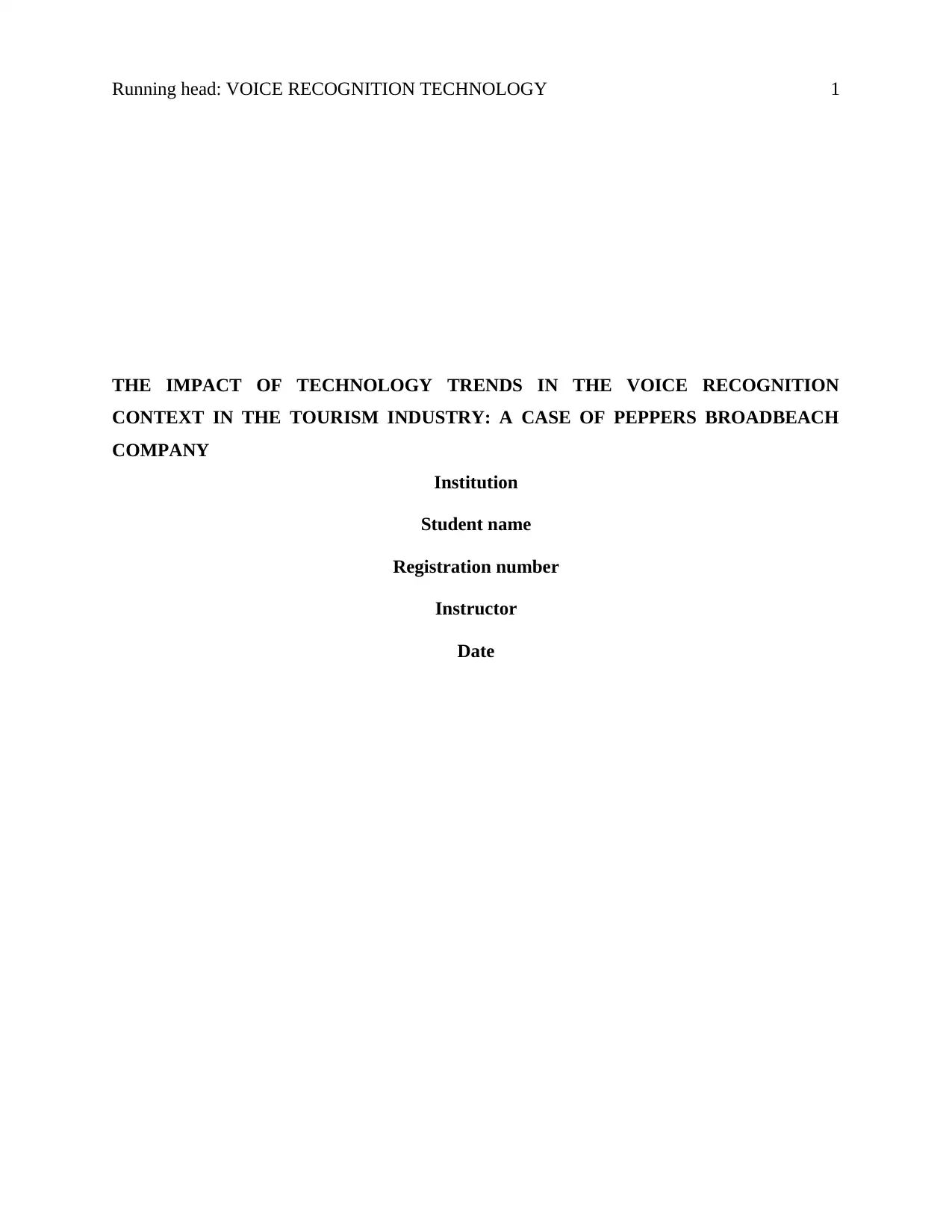
Running head: VOICE RECOGNITION TECHNOLOGY 1
THE IMPACT OF TECHNOLOGY TRENDS IN THE VOICE RECOGNITION
CONTEXT IN THE TOURISM INDUSTRY: A CASE OF PEPPERS BROADBEACH
COMPANY
Institution
Student name
Registration number
Instructor
Date
THE IMPACT OF TECHNOLOGY TRENDS IN THE VOICE RECOGNITION
CONTEXT IN THE TOURISM INDUSTRY: A CASE OF PEPPERS BROADBEACH
COMPANY
Institution
Student name
Registration number
Instructor
Date
Paraphrase This Document
Need a fresh take? Get an instant paraphrase of this document with our AI Paraphraser
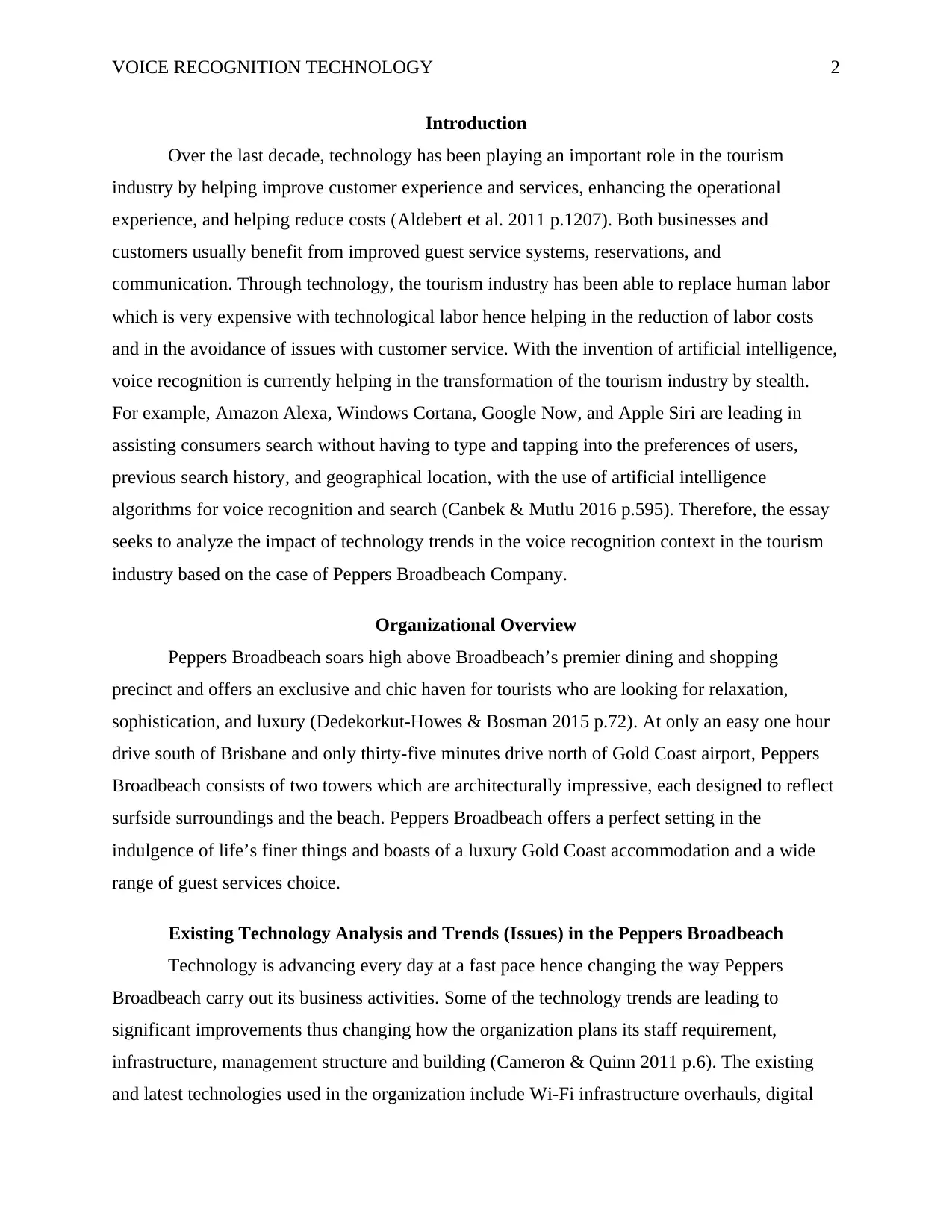
VOICE RECOGNITION TECHNOLOGY 2
Introduction
Over the last decade, technology has been playing an important role in the tourism
industry by helping improve customer experience and services, enhancing the operational
experience, and helping reduce costs (Aldebert et al. 2011 p.1207). Both businesses and
customers usually benefit from improved guest service systems, reservations, and
communication. Through technology, the tourism industry has been able to replace human labor
which is very expensive with technological labor hence helping in the reduction of labor costs
and in the avoidance of issues with customer service. With the invention of artificial intelligence,
voice recognition is currently helping in the transformation of the tourism industry by stealth.
For example, Amazon Alexa, Windows Cortana, Google Now, and Apple Siri are leading in
assisting consumers search without having to type and tapping into the preferences of users,
previous search history, and geographical location, with the use of artificial intelligence
algorithms for voice recognition and search (Canbek & Mutlu 2016 p.595). Therefore, the essay
seeks to analyze the impact of technology trends in the voice recognition context in the tourism
industry based on the case of Peppers Broadbeach Company.
Organizational Overview
Peppers Broadbeach soars high above Broadbeach’s premier dining and shopping
precinct and offers an exclusive and chic haven for tourists who are looking for relaxation,
sophistication, and luxury (Dedekorkut-Howes & Bosman 2015 p.72). At only an easy one hour
drive south of Brisbane and only thirty-five minutes drive north of Gold Coast airport, Peppers
Broadbeach consists of two towers which are architecturally impressive, each designed to reflect
surfside surroundings and the beach. Peppers Broadbeach offers a perfect setting in the
indulgence of life’s finer things and boasts of a luxury Gold Coast accommodation and a wide
range of guest services choice.
Existing Technology Analysis and Trends (Issues) in the Peppers Broadbeach
Technology is advancing every day at a fast pace hence changing the way Peppers
Broadbeach carry out its business activities. Some of the technology trends are leading to
significant improvements thus changing how the organization plans its staff requirement,
infrastructure, management structure and building (Cameron & Quinn 2011 p.6). The existing
and latest technologies used in the organization include Wi-Fi infrastructure overhauls, digital
Introduction
Over the last decade, technology has been playing an important role in the tourism
industry by helping improve customer experience and services, enhancing the operational
experience, and helping reduce costs (Aldebert et al. 2011 p.1207). Both businesses and
customers usually benefit from improved guest service systems, reservations, and
communication. Through technology, the tourism industry has been able to replace human labor
which is very expensive with technological labor hence helping in the reduction of labor costs
and in the avoidance of issues with customer service. With the invention of artificial intelligence,
voice recognition is currently helping in the transformation of the tourism industry by stealth.
For example, Amazon Alexa, Windows Cortana, Google Now, and Apple Siri are leading in
assisting consumers search without having to type and tapping into the preferences of users,
previous search history, and geographical location, with the use of artificial intelligence
algorithms for voice recognition and search (Canbek & Mutlu 2016 p.595). Therefore, the essay
seeks to analyze the impact of technology trends in the voice recognition context in the tourism
industry based on the case of Peppers Broadbeach Company.
Organizational Overview
Peppers Broadbeach soars high above Broadbeach’s premier dining and shopping
precinct and offers an exclusive and chic haven for tourists who are looking for relaxation,
sophistication, and luxury (Dedekorkut-Howes & Bosman 2015 p.72). At only an easy one hour
drive south of Brisbane and only thirty-five minutes drive north of Gold Coast airport, Peppers
Broadbeach consists of two towers which are architecturally impressive, each designed to reflect
surfside surroundings and the beach. Peppers Broadbeach offers a perfect setting in the
indulgence of life’s finer things and boasts of a luxury Gold Coast accommodation and a wide
range of guest services choice.
Existing Technology Analysis and Trends (Issues) in the Peppers Broadbeach
Technology is advancing every day at a fast pace hence changing the way Peppers
Broadbeach carry out its business activities. Some of the technology trends are leading to
significant improvements thus changing how the organization plans its staff requirement,
infrastructure, management structure and building (Cameron & Quinn 2011 p.6). The existing
and latest technologies used in the organization include Wi-Fi infrastructure overhauls, digital
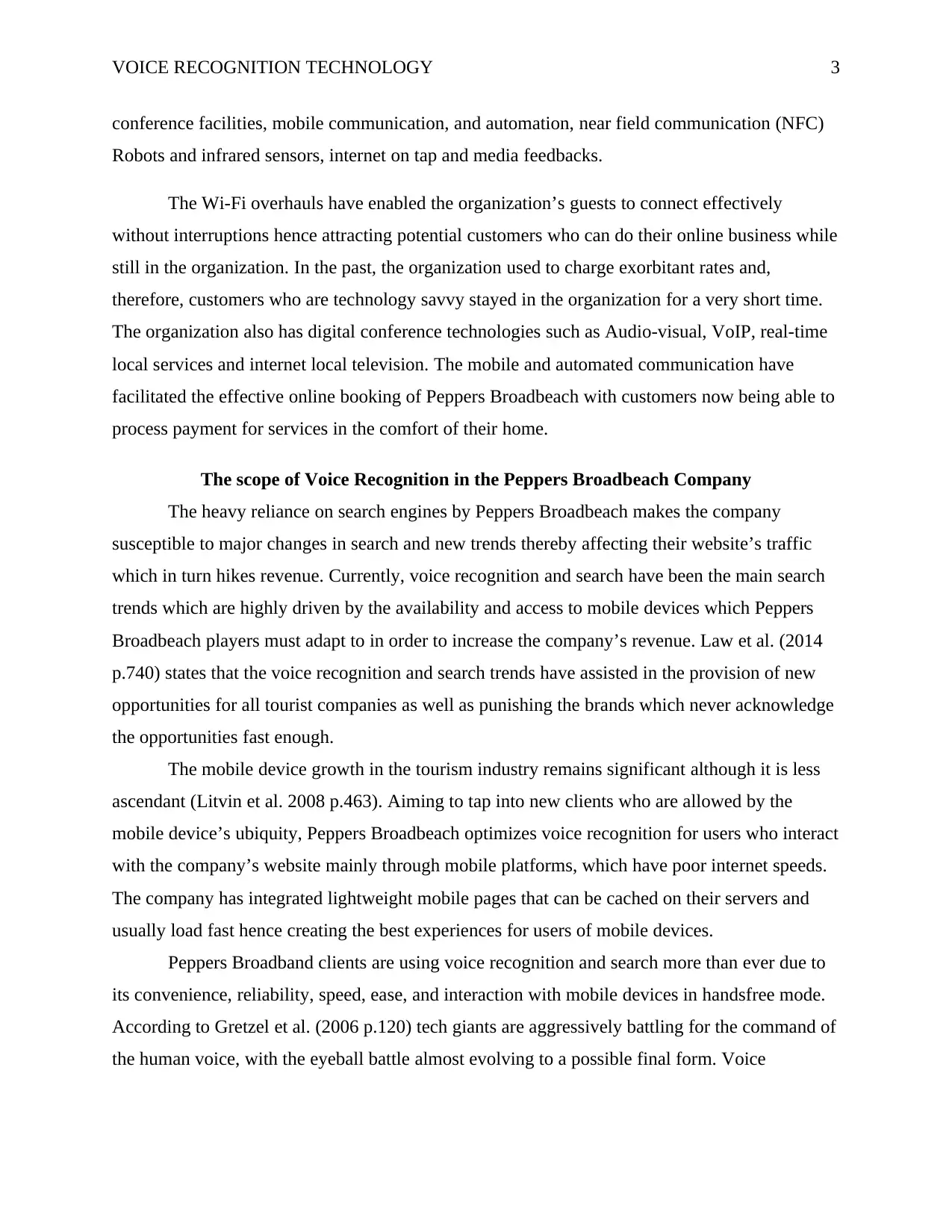
VOICE RECOGNITION TECHNOLOGY 3
conference facilities, mobile communication, and automation, near field communication (NFC)
Robots and infrared sensors, internet on tap and media feedbacks.
The Wi-Fi overhauls have enabled the organization’s guests to connect effectively
without interruptions hence attracting potential customers who can do their online business while
still in the organization. In the past, the organization used to charge exorbitant rates and,
therefore, customers who are technology savvy stayed in the organization for a very short time.
The organization also has digital conference technologies such as Audio-visual, VoIP, real-time
local services and internet local television. The mobile and automated communication have
facilitated the effective online booking of Peppers Broadbeach with customers now being able to
process payment for services in the comfort of their home.
The scope of Voice Recognition in the Peppers Broadbeach Company
The heavy reliance on search engines by Peppers Broadbeach makes the company
susceptible to major changes in search and new trends thereby affecting their website’s traffic
which in turn hikes revenue. Currently, voice recognition and search have been the main search
trends which are highly driven by the availability and access to mobile devices which Peppers
Broadbeach players must adapt to in order to increase the company’s revenue. Law et al. (2014
p.740) states that the voice recognition and search trends have assisted in the provision of new
opportunities for all tourist companies as well as punishing the brands which never acknowledge
the opportunities fast enough.
The mobile device growth in the tourism industry remains significant although it is less
ascendant (Litvin et al. 2008 p.463). Aiming to tap into new clients who are allowed by the
mobile device’s ubiquity, Peppers Broadbeach optimizes voice recognition for users who interact
with the company’s website mainly through mobile platforms, which have poor internet speeds.
The company has integrated lightweight mobile pages that can be cached on their servers and
usually load fast hence creating the best experiences for users of mobile devices.
Peppers Broadband clients are using voice recognition and search more than ever due to
its convenience, reliability, speed, ease, and interaction with mobile devices in handsfree mode.
According to Gretzel et al. (2006 p.120) tech giants are aggressively battling for the command of
the human voice, with the eyeball battle almost evolving to a possible final form. Voice
conference facilities, mobile communication, and automation, near field communication (NFC)
Robots and infrared sensors, internet on tap and media feedbacks.
The Wi-Fi overhauls have enabled the organization’s guests to connect effectively
without interruptions hence attracting potential customers who can do their online business while
still in the organization. In the past, the organization used to charge exorbitant rates and,
therefore, customers who are technology savvy stayed in the organization for a very short time.
The organization also has digital conference technologies such as Audio-visual, VoIP, real-time
local services and internet local television. The mobile and automated communication have
facilitated the effective online booking of Peppers Broadbeach with customers now being able to
process payment for services in the comfort of their home.
The scope of Voice Recognition in the Peppers Broadbeach Company
The heavy reliance on search engines by Peppers Broadbeach makes the company
susceptible to major changes in search and new trends thereby affecting their website’s traffic
which in turn hikes revenue. Currently, voice recognition and search have been the main search
trends which are highly driven by the availability and access to mobile devices which Peppers
Broadbeach players must adapt to in order to increase the company’s revenue. Law et al. (2014
p.740) states that the voice recognition and search trends have assisted in the provision of new
opportunities for all tourist companies as well as punishing the brands which never acknowledge
the opportunities fast enough.
The mobile device growth in the tourism industry remains significant although it is less
ascendant (Litvin et al. 2008 p.463). Aiming to tap into new clients who are allowed by the
mobile device’s ubiquity, Peppers Broadbeach optimizes voice recognition for users who interact
with the company’s website mainly through mobile platforms, which have poor internet speeds.
The company has integrated lightweight mobile pages that can be cached on their servers and
usually load fast hence creating the best experiences for users of mobile devices.
Peppers Broadband clients are using voice recognition and search more than ever due to
its convenience, reliability, speed, ease, and interaction with mobile devices in handsfree mode.
According to Gretzel et al. (2006 p.120) tech giants are aggressively battling for the command of
the human voice, with the eyeball battle almost evolving to a possible final form. Voice
⊘ This is a preview!⊘
Do you want full access?
Subscribe today to unlock all pages.

Trusted by 1+ million students worldwide
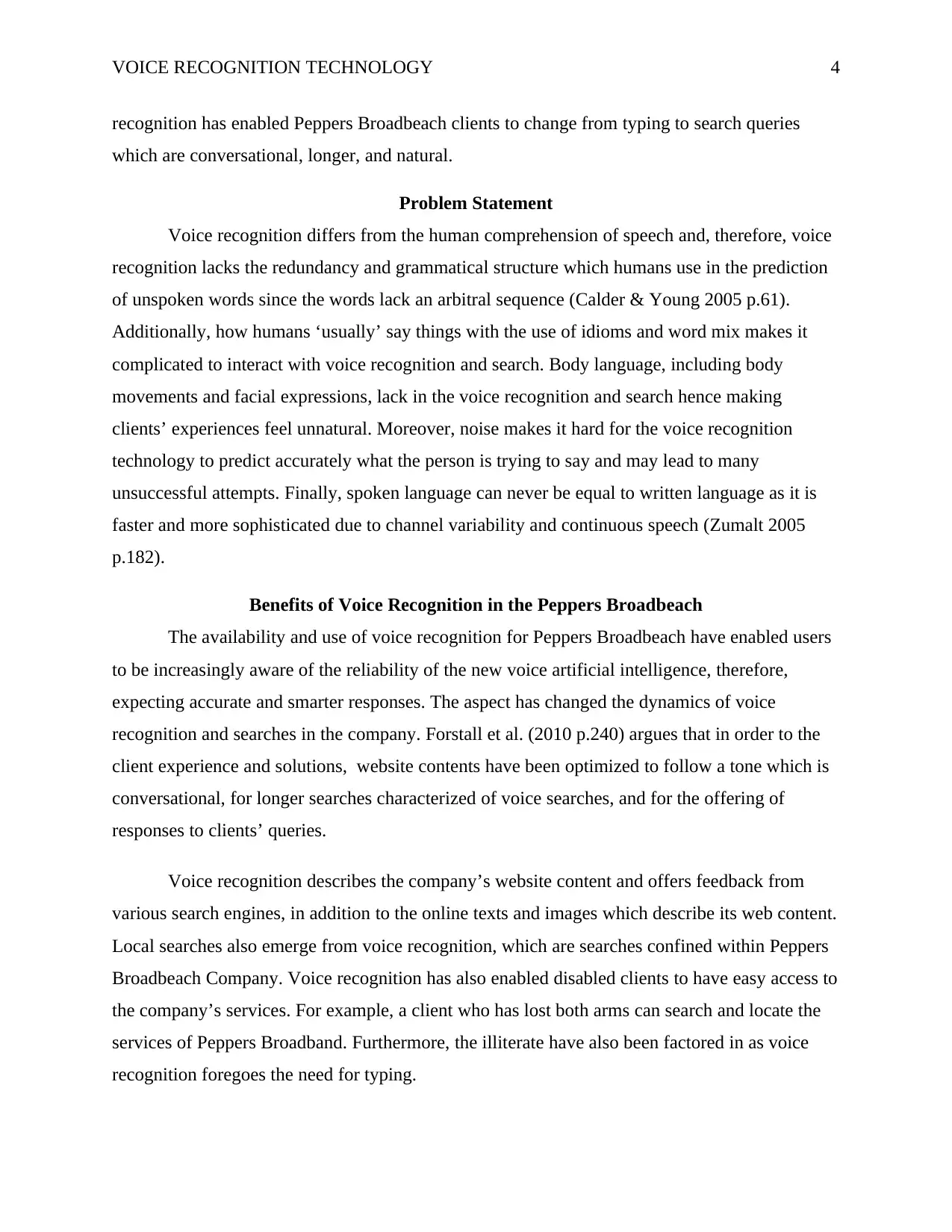
VOICE RECOGNITION TECHNOLOGY 4
recognition has enabled Peppers Broadbeach clients to change from typing to search queries
which are conversational, longer, and natural.
Problem Statement
Voice recognition differs from the human comprehension of speech and, therefore, voice
recognition lacks the redundancy and grammatical structure which humans use in the prediction
of unspoken words since the words lack an arbitral sequence (Calder & Young 2005 p.61).
Additionally, how humans ‘usually’ say things with the use of idioms and word mix makes it
complicated to interact with voice recognition and search. Body language, including body
movements and facial expressions, lack in the voice recognition and search hence making
clients’ experiences feel unnatural. Moreover, noise makes it hard for the voice recognition
technology to predict accurately what the person is trying to say and may lead to many
unsuccessful attempts. Finally, spoken language can never be equal to written language as it is
faster and more sophisticated due to channel variability and continuous speech (Zumalt 2005
p.182).
Benefits of Voice Recognition in the Peppers Broadbeach
The availability and use of voice recognition for Peppers Broadbeach have enabled users
to be increasingly aware of the reliability of the new voice artificial intelligence, therefore,
expecting accurate and smarter responses. The aspect has changed the dynamics of voice
recognition and searches in the company. Forstall et al. (2010 p.240) argues that in order to the
client experience and solutions, website contents have been optimized to follow a tone which is
conversational, for longer searches characterized of voice searches, and for the offering of
responses to clients’ queries.
Voice recognition describes the company’s website content and offers feedback from
various search engines, in addition to the online texts and images which describe its web content.
Local searches also emerge from voice recognition, which are searches confined within Peppers
Broadbeach Company. Voice recognition has also enabled disabled clients to have easy access to
the company’s services. For example, a client who has lost both arms can search and locate the
services of Peppers Broadband. Furthermore, the illiterate have also been factored in as voice
recognition foregoes the need for typing.
recognition has enabled Peppers Broadbeach clients to change from typing to search queries
which are conversational, longer, and natural.
Problem Statement
Voice recognition differs from the human comprehension of speech and, therefore, voice
recognition lacks the redundancy and grammatical structure which humans use in the prediction
of unspoken words since the words lack an arbitral sequence (Calder & Young 2005 p.61).
Additionally, how humans ‘usually’ say things with the use of idioms and word mix makes it
complicated to interact with voice recognition and search. Body language, including body
movements and facial expressions, lack in the voice recognition and search hence making
clients’ experiences feel unnatural. Moreover, noise makes it hard for the voice recognition
technology to predict accurately what the person is trying to say and may lead to many
unsuccessful attempts. Finally, spoken language can never be equal to written language as it is
faster and more sophisticated due to channel variability and continuous speech (Zumalt 2005
p.182).
Benefits of Voice Recognition in the Peppers Broadbeach
The availability and use of voice recognition for Peppers Broadbeach have enabled users
to be increasingly aware of the reliability of the new voice artificial intelligence, therefore,
expecting accurate and smarter responses. The aspect has changed the dynamics of voice
recognition and searches in the company. Forstall et al. (2010 p.240) argues that in order to the
client experience and solutions, website contents have been optimized to follow a tone which is
conversational, for longer searches characterized of voice searches, and for the offering of
responses to clients’ queries.
Voice recognition describes the company’s website content and offers feedback from
various search engines, in addition to the online texts and images which describe its web content.
Local searches also emerge from voice recognition, which are searches confined within Peppers
Broadbeach Company. Voice recognition has also enabled disabled clients to have easy access to
the company’s services. For example, a client who has lost both arms can search and locate the
services of Peppers Broadband. Furthermore, the illiterate have also been factored in as voice
recognition foregoes the need for typing.
Paraphrase This Document
Need a fresh take? Get an instant paraphrase of this document with our AI Paraphraser
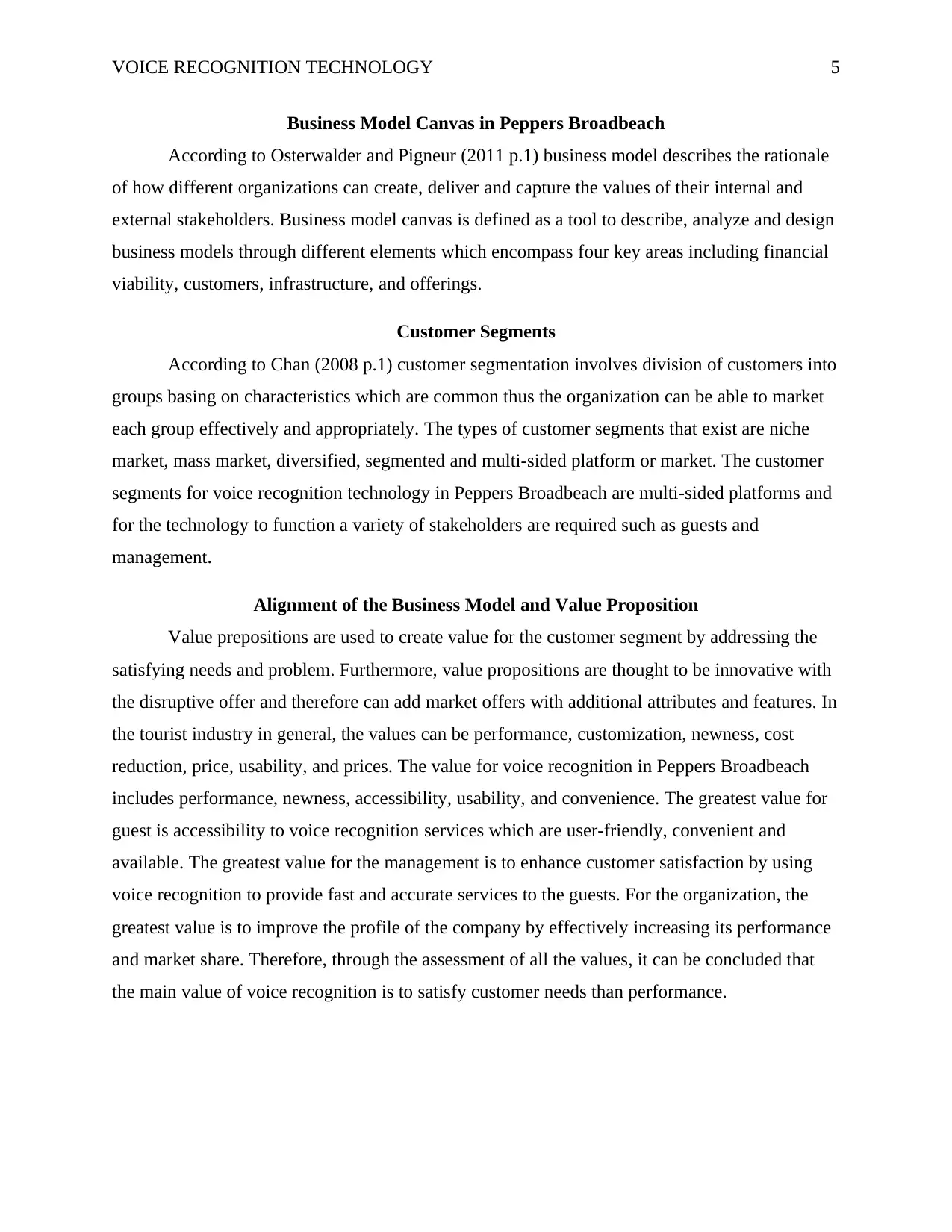
VOICE RECOGNITION TECHNOLOGY 5
Business Model Canvas in Peppers Broadbeach
According to Osterwalder and Pigneur (2011 p.1) business model describes the rationale
of how different organizations can create, deliver and capture the values of their internal and
external stakeholders. Business model canvas is defined as a tool to describe, analyze and design
business models through different elements which encompass four key areas including financial
viability, customers, infrastructure, and offerings.
Customer Segments
According to Chan (2008 p.1) customer segmentation involves division of customers into
groups basing on characteristics which are common thus the organization can be able to market
each group effectively and appropriately. The types of customer segments that exist are niche
market, mass market, diversified, segmented and multi-sided platform or market. The customer
segments for voice recognition technology in Peppers Broadbeach are multi-sided platforms and
for the technology to function a variety of stakeholders are required such as guests and
management.
Alignment of the Business Model and Value Proposition
Value prepositions are used to create value for the customer segment by addressing the
satisfying needs and problem. Furthermore, value propositions are thought to be innovative with
the disruptive offer and therefore can add market offers with additional attributes and features. In
the tourist industry in general, the values can be performance, customization, newness, cost
reduction, price, usability, and prices. The value for voice recognition in Peppers Broadbeach
includes performance, newness, accessibility, usability, and convenience. The greatest value for
guest is accessibility to voice recognition services which are user-friendly, convenient and
available. The greatest value for the management is to enhance customer satisfaction by using
voice recognition to provide fast and accurate services to the guests. For the organization, the
greatest value is to improve the profile of the company by effectively increasing its performance
and market share. Therefore, through the assessment of all the values, it can be concluded that
the main value of voice recognition is to satisfy customer needs than performance.
Business Model Canvas in Peppers Broadbeach
According to Osterwalder and Pigneur (2011 p.1) business model describes the rationale
of how different organizations can create, deliver and capture the values of their internal and
external stakeholders. Business model canvas is defined as a tool to describe, analyze and design
business models through different elements which encompass four key areas including financial
viability, customers, infrastructure, and offerings.
Customer Segments
According to Chan (2008 p.1) customer segmentation involves division of customers into
groups basing on characteristics which are common thus the organization can be able to market
each group effectively and appropriately. The types of customer segments that exist are niche
market, mass market, diversified, segmented and multi-sided platform or market. The customer
segments for voice recognition technology in Peppers Broadbeach are multi-sided platforms and
for the technology to function a variety of stakeholders are required such as guests and
management.
Alignment of the Business Model and Value Proposition
Value prepositions are used to create value for the customer segment by addressing the
satisfying needs and problem. Furthermore, value propositions are thought to be innovative with
the disruptive offer and therefore can add market offers with additional attributes and features. In
the tourist industry in general, the values can be performance, customization, newness, cost
reduction, price, usability, and prices. The value for voice recognition in Peppers Broadbeach
includes performance, newness, accessibility, usability, and convenience. The greatest value for
guest is accessibility to voice recognition services which are user-friendly, convenient and
available. The greatest value for the management is to enhance customer satisfaction by using
voice recognition to provide fast and accurate services to the guests. For the organization, the
greatest value is to improve the profile of the company by effectively increasing its performance
and market share. Therefore, through the assessment of all the values, it can be concluded that
the main value of voice recognition is to satisfy customer needs than performance.
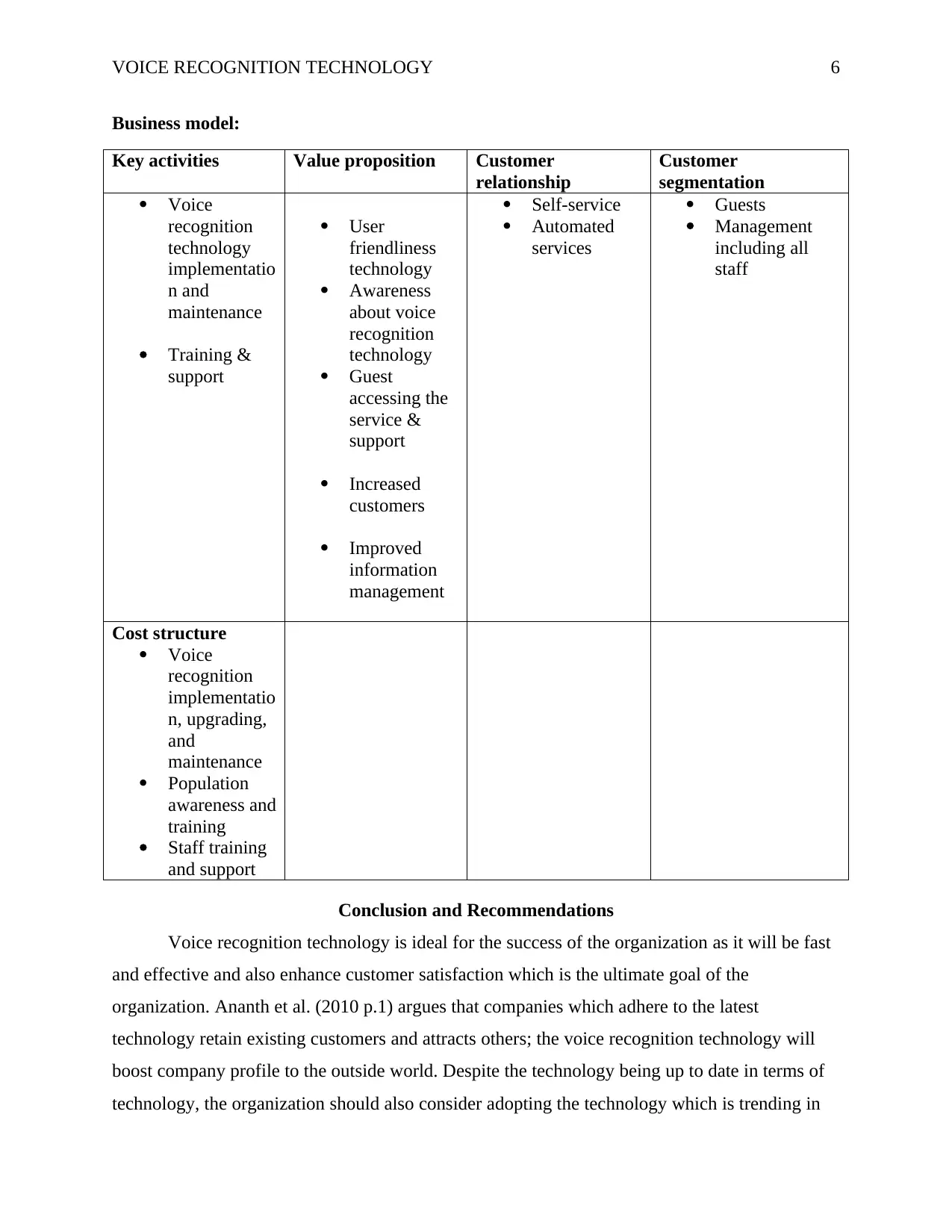
VOICE RECOGNITION TECHNOLOGY 6
Business model:
Key activities Value proposition Customer
relationship
Customer
segmentation
Voice
recognition
technology
implementatio
n and
maintenance
Training &
support
User
friendliness
technology
Awareness
about voice
recognition
technology
Guest
accessing the
service &
support
Increased
customers
Improved
information
management
Self-service
Automated
services
Guests
Management
including all
staff
Cost structure
Voice
recognition
implementatio
n, upgrading,
and
maintenance
Population
awareness and
training
Staff training
and support
Conclusion and Recommendations
Voice recognition technology is ideal for the success of the organization as it will be fast
and effective and also enhance customer satisfaction which is the ultimate goal of the
organization. Ananth et al. (2010 p.1) argues that companies which adhere to the latest
technology retain existing customers and attracts others; the voice recognition technology will
boost company profile to the outside world. Despite the technology being up to date in terms of
technology, the organization should also consider adopting the technology which is trending in
Business model:
Key activities Value proposition Customer
relationship
Customer
segmentation
Voice
recognition
technology
implementatio
n and
maintenance
Training &
support
User
friendliness
technology
Awareness
about voice
recognition
technology
Guest
accessing the
service &
support
Increased
customers
Improved
information
management
Self-service
Automated
services
Guests
Management
including all
staff
Cost structure
Voice
recognition
implementatio
n, upgrading,
and
maintenance
Population
awareness and
training
Staff training
and support
Conclusion and Recommendations
Voice recognition technology is ideal for the success of the organization as it will be fast
and effective and also enhance customer satisfaction which is the ultimate goal of the
organization. Ananth et al. (2010 p.1) argues that companies which adhere to the latest
technology retain existing customers and attracts others; the voice recognition technology will
boost company profile to the outside world. Despite the technology being up to date in terms of
technology, the organization should also consider adopting the technology which is trending in
⊘ This is a preview!⊘
Do you want full access?
Subscribe today to unlock all pages.

Trusted by 1+ million students worldwide
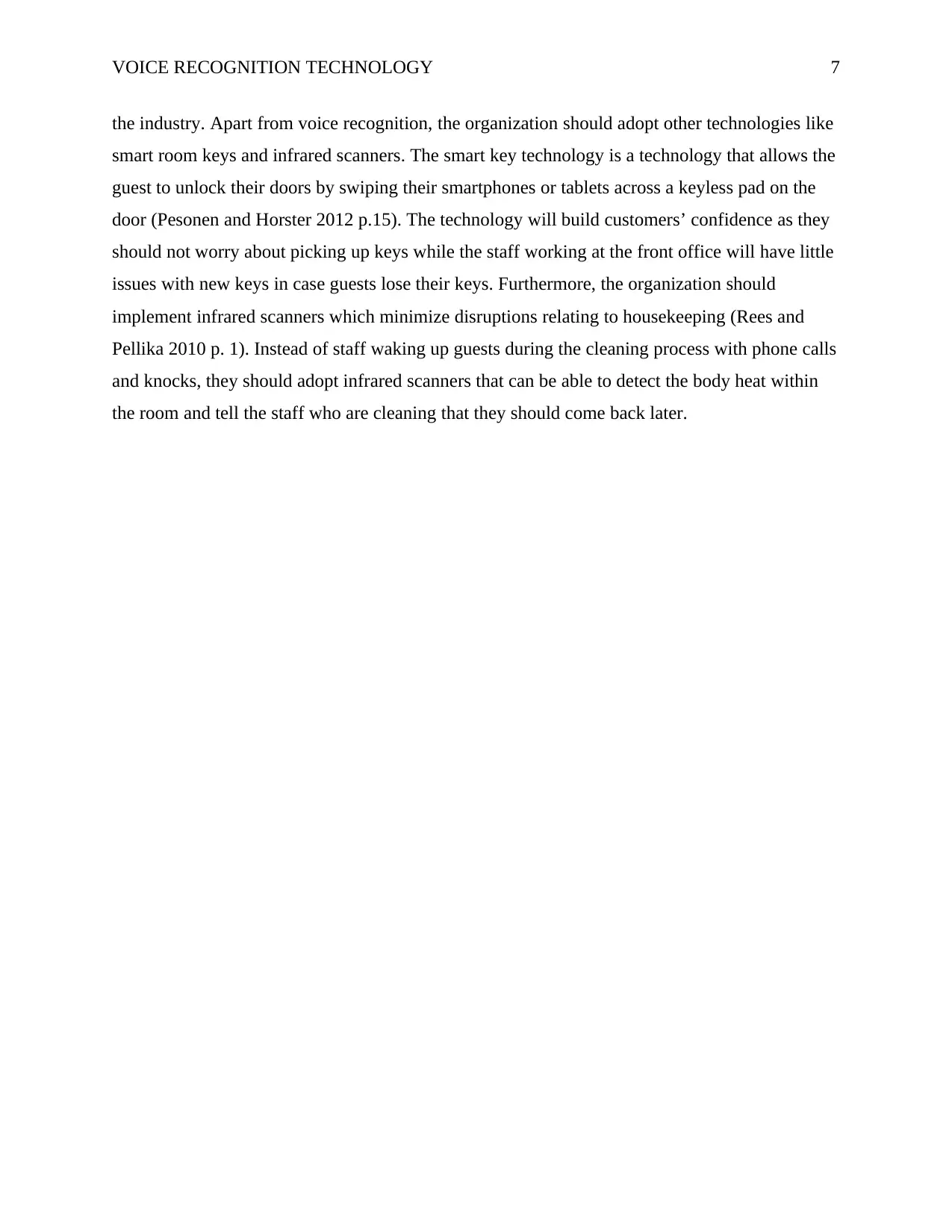
VOICE RECOGNITION TECHNOLOGY 7
the industry. Apart from voice recognition, the organization should adopt other technologies like
smart room keys and infrared scanners. The smart key technology is a technology that allows the
guest to unlock their doors by swiping their smartphones or tablets across a keyless pad on the
door (Pesonen and Horster 2012 p.15). The technology will build customers’ confidence as they
should not worry about picking up keys while the staff working at the front office will have little
issues with new keys in case guests lose their keys. Furthermore, the organization should
implement infrared scanners which minimize disruptions relating to housekeeping (Rees and
Pellika 2010 p. 1). Instead of staff waking up guests during the cleaning process with phone calls
and knocks, they should adopt infrared scanners that can be able to detect the body heat within
the room and tell the staff who are cleaning that they should come back later.
the industry. Apart from voice recognition, the organization should adopt other technologies like
smart room keys and infrared scanners. The smart key technology is a technology that allows the
guest to unlock their doors by swiping their smartphones or tablets across a keyless pad on the
door (Pesonen and Horster 2012 p.15). The technology will build customers’ confidence as they
should not worry about picking up keys while the staff working at the front office will have little
issues with new keys in case guests lose their keys. Furthermore, the organization should
implement infrared scanners which minimize disruptions relating to housekeeping (Rees and
Pellika 2010 p. 1). Instead of staff waking up guests during the cleaning process with phone calls
and knocks, they should adopt infrared scanners that can be able to detect the body heat within
the room and tell the staff who are cleaning that they should come back later.
Paraphrase This Document
Need a fresh take? Get an instant paraphrase of this document with our AI Paraphraser
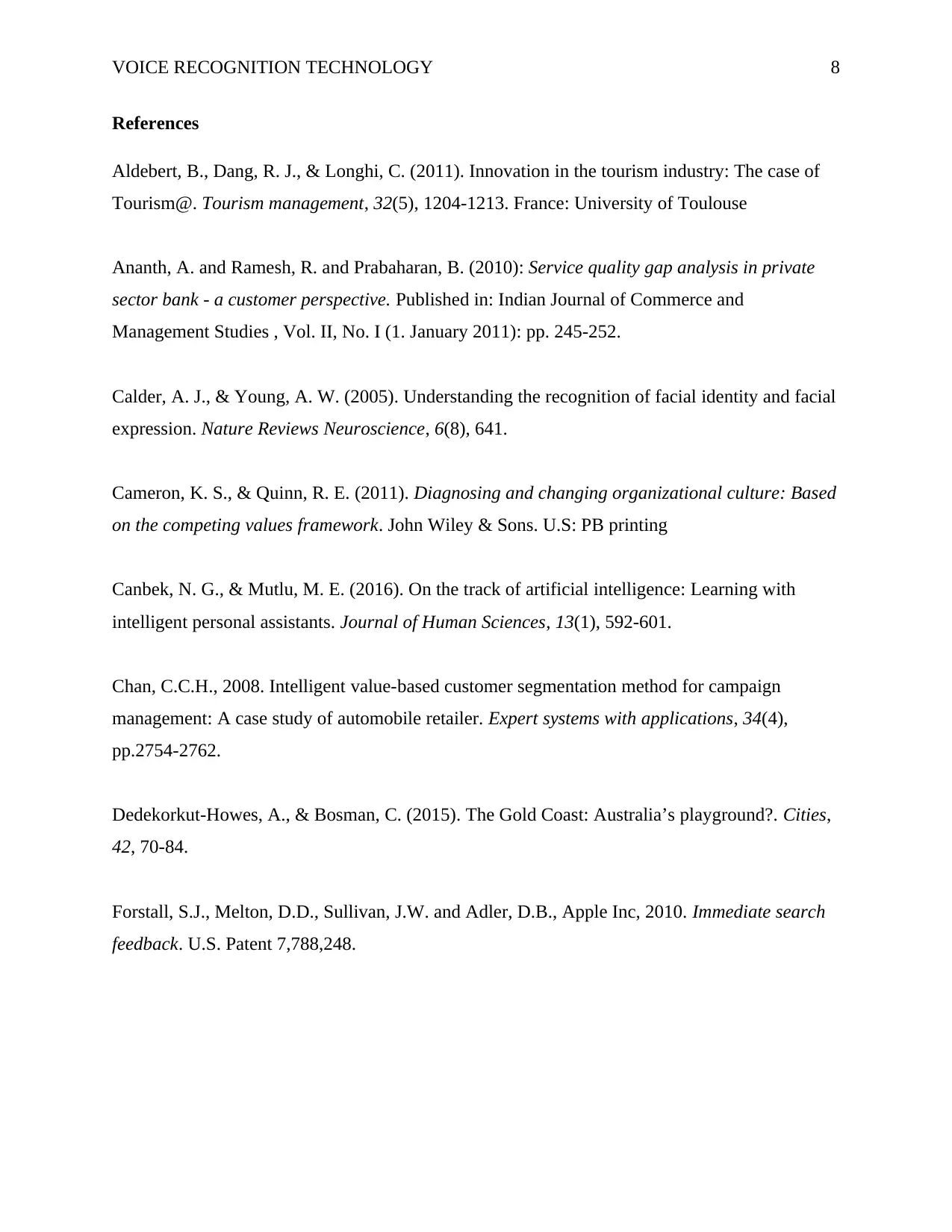
VOICE RECOGNITION TECHNOLOGY 8
References
Aldebert, B., Dang, R. J., & Longhi, C. (2011). Innovation in the tourism industry: The case of
Tourism@. Tourism management, 32(5), 1204-1213. France: University of Toulouse
Ananth, A. and Ramesh, R. and Prabaharan, B. (2010): Service quality gap analysis in private
sector bank - a customer perspective. Published in: Indian Journal of Commerce and
Management Studies , Vol. II, No. I (1. January 2011): pp. 245-252.
Calder, A. J., & Young, A. W. (2005). Understanding the recognition of facial identity and facial
expression. Nature Reviews Neuroscience, 6(8), 641.
Cameron, K. S., & Quinn, R. E. (2011). Diagnosing and changing organizational culture: Based
on the competing values framework. John Wiley & Sons. U.S: PB printing
Canbek, N. G., & Mutlu, M. E. (2016). On the track of artificial intelligence: Learning with
intelligent personal assistants. Journal of Human Sciences, 13(1), 592-601.
Chan, C.C.H., 2008. Intelligent value-based customer segmentation method for campaign
management: A case study of automobile retailer. Expert systems with applications, 34(4),
pp.2754-2762.
Dedekorkut-Howes, A., & Bosman, C. (2015). The Gold Coast: Australia’s playground?. Cities,
42, 70-84.
Forstall, S.J., Melton, D.D., Sullivan, J.W. and Adler, D.B., Apple Inc, 2010. Immediate search
feedback. U.S. Patent 7,788,248.
References
Aldebert, B., Dang, R. J., & Longhi, C. (2011). Innovation in the tourism industry: The case of
Tourism@. Tourism management, 32(5), 1204-1213. France: University of Toulouse
Ananth, A. and Ramesh, R. and Prabaharan, B. (2010): Service quality gap analysis in private
sector bank - a customer perspective. Published in: Indian Journal of Commerce and
Management Studies , Vol. II, No. I (1. January 2011): pp. 245-252.
Calder, A. J., & Young, A. W. (2005). Understanding the recognition of facial identity and facial
expression. Nature Reviews Neuroscience, 6(8), 641.
Cameron, K. S., & Quinn, R. E. (2011). Diagnosing and changing organizational culture: Based
on the competing values framework. John Wiley & Sons. U.S: PB printing
Canbek, N. G., & Mutlu, M. E. (2016). On the track of artificial intelligence: Learning with
intelligent personal assistants. Journal of Human Sciences, 13(1), 592-601.
Chan, C.C.H., 2008. Intelligent value-based customer segmentation method for campaign
management: A case study of automobile retailer. Expert systems with applications, 34(4),
pp.2754-2762.
Dedekorkut-Howes, A., & Bosman, C. (2015). The Gold Coast: Australia’s playground?. Cities,
42, 70-84.
Forstall, S.J., Melton, D.D., Sullivan, J.W. and Adler, D.B., Apple Inc, 2010. Immediate search
feedback. U.S. Patent 7,788,248.
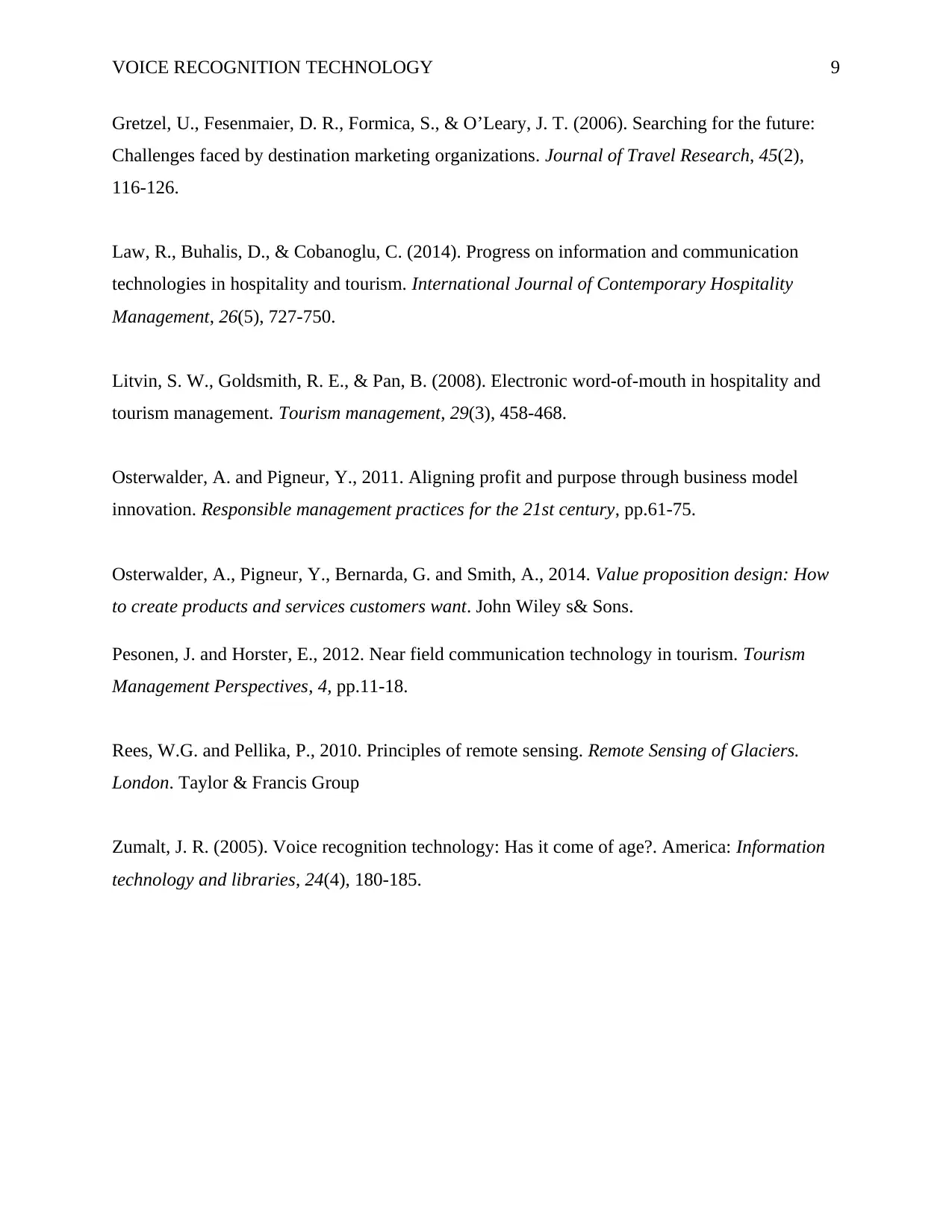
VOICE RECOGNITION TECHNOLOGY 9
Gretzel, U., Fesenmaier, D. R., Formica, S., & O’Leary, J. T. (2006). Searching for the future:
Challenges faced by destination marketing organizations. Journal of Travel Research, 45(2),
116-126.
Law, R., Buhalis, D., & Cobanoglu, C. (2014). Progress on information and communication
technologies in hospitality and tourism. International Journal of Contemporary Hospitality
Management, 26(5), 727-750.
Litvin, S. W., Goldsmith, R. E., & Pan, B. (2008). Electronic word-of-mouth in hospitality and
tourism management. Tourism management, 29(3), 458-468.
Osterwalder, A. and Pigneur, Y., 2011. Aligning profit and purpose through business model
innovation. Responsible management practices for the 21st century, pp.61-75.
Osterwalder, A., Pigneur, Y., Bernarda, G. and Smith, A., 2014. Value proposition design: How
to create products and services customers want. John Wiley s& Sons.
Pesonen, J. and Horster, E., 2012. Near field communication technology in tourism. Tourism
Management Perspectives, 4, pp.11-18.
Rees, W.G. and Pellika, P., 2010. Principles of remote sensing. Remote Sensing of Glaciers.
London. Taylor & Francis Group
Zumalt, J. R. (2005). Voice recognition technology: Has it come of age?. America: Information
technology and libraries, 24(4), 180-185.
Gretzel, U., Fesenmaier, D. R., Formica, S., & O’Leary, J. T. (2006). Searching for the future:
Challenges faced by destination marketing organizations. Journal of Travel Research, 45(2),
116-126.
Law, R., Buhalis, D., & Cobanoglu, C. (2014). Progress on information and communication
technologies in hospitality and tourism. International Journal of Contemporary Hospitality
Management, 26(5), 727-750.
Litvin, S. W., Goldsmith, R. E., & Pan, B. (2008). Electronic word-of-mouth in hospitality and
tourism management. Tourism management, 29(3), 458-468.
Osterwalder, A. and Pigneur, Y., 2011. Aligning profit and purpose through business model
innovation. Responsible management practices for the 21st century, pp.61-75.
Osterwalder, A., Pigneur, Y., Bernarda, G. and Smith, A., 2014. Value proposition design: How
to create products and services customers want. John Wiley s& Sons.
Pesonen, J. and Horster, E., 2012. Near field communication technology in tourism. Tourism
Management Perspectives, 4, pp.11-18.
Rees, W.G. and Pellika, P., 2010. Principles of remote sensing. Remote Sensing of Glaciers.
London. Taylor & Francis Group
Zumalt, J. R. (2005). Voice recognition technology: Has it come of age?. America: Information
technology and libraries, 24(4), 180-185.
⊘ This is a preview!⊘
Do you want full access?
Subscribe today to unlock all pages.

Trusted by 1+ million students worldwide
1 out of 9
Your All-in-One AI-Powered Toolkit for Academic Success.
+13062052269
info@desklib.com
Available 24*7 on WhatsApp / Email
![[object Object]](/_next/static/media/star-bottom.7253800d.svg)
Unlock your academic potential
Copyright © 2020–2025 A2Z Services. All Rights Reserved. Developed and managed by ZUCOL.
